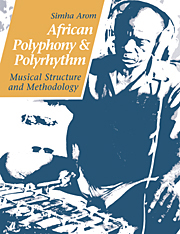Book contents
- Frontmatter
- Contents
- List of illustrations
- Foreword by György Ligeti
- Preface
- Acknowledgements
- BOOK I THE MUSIC OF THE CENTRAL AFRICAN REPUBLIC
- BOOK II AFRICAN POLYPHONIC MUSIC
- BOOK III TECHNICAL TOOLS: METHODS OF RECORDING POLYPHONIC MUSIC FOR TRANSCRIPTION
- BOOK IV THEORETICAL TOOLS
- BOOK V THE ORGANISATION OF TIME IN AFRICAN MUSIC
- BOOK VI STRUCTURAL PRINCIPLES AND THEIR APPLICATION
- 1 Typology
- 2 Analytical notions
- 3 Strict polyrhythmics
- 4 Polyrhythmics as a way to polyphony: Hocket
- 5 Polyphony produced by melodic instruments
- 6 The association of polyphony and polyrhythmics
- Conclusion
- Bibliography
1 - Typology
Published online by Cambridge University Press: 27 January 2010
- Frontmatter
- Contents
- List of illustrations
- Foreword by György Ligeti
- Preface
- Acknowledgements
- BOOK I THE MUSIC OF THE CENTRAL AFRICAN REPUBLIC
- BOOK II AFRICAN POLYPHONIC MUSIC
- BOOK III TECHNICAL TOOLS: METHODS OF RECORDING POLYPHONIC MUSIC FOR TRANSCRIPTION
- BOOK IV THEORETICAL TOOLS
- BOOK V THE ORGANISATION OF TIME IN AFRICAN MUSIC
- BOOK VI STRUCTURAL PRINCIPLES AND THEIR APPLICATION
- 1 Typology
- 2 Analytical notions
- 3 Strict polyrhythmics
- 4 Polyrhythmics as a way to polyphony: Hocket
- 5 Polyphony produced by melodic instruments
- 6 The association of polyphony and polyrhythmics
- Conclusion
- Bibliography
Summary
In Book I, we have shown that traditional Central African music consists essentially of the strictly periodic repetition of similar material, with variations. Polyphonic music is naturally no exception to this principle. The overall structure of Central African polyphony of whatever type can be defined as an ostinato with variations. This definition is wide enough to cover all the observed melodic and rhythmic variety of this music, and still remain the shortest and most concise way of describing its cyclical nature. To avoid confusion, a clear distinction must be made between the ‘tools’ involved in producing this polyphony and the musical techniques employed.
The tools are the human voice and the musical instruments, used individually or in combination. These tools may vary not only from one ethnic group to another, but even within a single population, according to the type of repertory, which will itself be linked to a specific social function. The techniques are the structured ways in which these tools are actually used to produce polyphony.
Years of field work have convinced me that the techniques involved in the production of Central African polyphonic and polyrhythmic structures are few in number.
From a purely systematic, but still abstract, point of view, all polyphony and polyrhythmics in this region can be classified into four types:
(1) strict polyrhythmics
(2) polyphony produced by hocket
(3) polyphony produced by melodic instruments
(4) vocal polyphony
These are the basic elements, but the musical reality is more complex and requires further discussion. This is because all of these types, with the exception of hocket polyphony, which works differently, can be combined in various ways.
- Type
- Chapter
- Information
- African Polyphony and PolyrhythmMusical Structure and Methodology, pp. 215 - 217Publisher: Cambridge University PressPrint publication year: 1991



